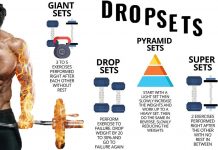🚨 BUILD BIGGER LEGS EXERCISES
✅ Legs can be one of the most stubborn body parts for men to see a drastic change in. If you’re just starting off in a muscle-building regimen—hoping to bulk your chicken legs, pull off some stylish short shorts, or get muscle definition —improving your leg musculature all begins with the basics
[wp_ad_camp_2]
🚨 Leg Press

[wp_ad_camp_1]
✅ First, let’s talk about what many trainers hate about the leg press: It can cause lower-back injury when done incorrectly. And when guys load every last plate in the gym on the sled and try to half-ass a few reps out, with their lower back disengaging from the pad on every rep in part due to woefully inflexible hamstrings and glutes, that’s about as incorrect as you can get. It’s true that it’s one of the most abused exercises in the gym — probably because you can feel like a big shot and handle much more weight than you can on a squat — but used carefully, the leg press can be very beneficial. And just as important, it helps provide variety in what might otherwise be a very squat-centric leg program.
✅ How-To: Sit squarely in the leg press machine and place your feet shoulder-width apart on the sled. Keeping your chest up and lower back pressed into the pad, carefully unlatch the sled from the safeties. Bend your knees to lower the platform, stopping before your glutes lift off the pad. From there, powerfully extend your knees to press the weight up (but don’t lock them out at the top).
🚨 TIP 1 SIT BACK TO SQUAT
[wp_ad_camp_4]
✅ Although squatting is a basic human movement, many people do it incorrectly. The most helpful cue to remember when you’re squatting is to sit back. “Don’t squat by bending your knees so they move over your toes,”. “Instead, move your hips back while you push your knees out.”

quatting by bending your knees and moving them forward puts a lot of strain on your knees and makes the movement far less effective. So, try to sit back like you’re sitting in a chair. If you don’t have the balance to accomplish the lift this way, start by practicing the movement without weight. Sit down to a bench by moving your hips back. When your butt touches the bench, stand back up. As you get more comfortable with the movement pattern, add some weight.
[wp_ad_camp_3]
By making the movement hip instead of knee dominant, you’ll get much greater glute and hamstring activation. Squatting this way will also help you train your entire posterior chain—hamstrings, glutes, lower back, adductors—to work as a system, strengthening your entire body.
🚨 How To Do The Leg Extension
✅ Sit up straight on the leg extension machine – imagine you have a seat belt pulling your waist into the seat. Adjust the pad so it sits on top of your shins just above your feet, which should be pointing forward. Hold the side bars. Ensuring that you are using your quads to power the movement, rather than kicking up with your feet, extend your legs straight out in front of you. Then slowly lower them back to the starting position.
[wp_ad_camp_5]

🚨 Hack Squat
[wp_ad_camp_2]
✅ While the barbell version of the hack squat — picking up a barbell placed behind you — is perfectly acceptable, especially for those training at home, the typical machine-based hack squat you find at most gyms is our choice here. That’s the one that’s plate-loaded and angles your body slightly backward. Within the confines of the machine, you’ll find a bit more safety than you would with the free-weight squat, which becomes more crucial as you tire during a workout. That means hacks are a great mid-workout option, serving as a bridge between squatting and other moves such as the leg press and lunge.

[wp_ad_camp_1]
✅ How-To: Step inside a hack squat machine, placing your shoulders and back against the pads. Set your feet at mid-platform just inside shoulder width, keeping your feet flat throughout the exercise. With your chest up and core tight, unhook the safeties and slowly lower yourself, stopping when your thighs are just past parallel to the platform. From here, powerfully press upward to the start position, keeping your knees bent slightly at the top to protect them from hyperextension. “When performing any squat movement, my cues are always to avoid any excessive internal or external rotation at the knees — think the ‘knock-knee’ position or knees and toes pointing out — along with keeping your knees about shoulder-width apart throughout the movement,” Flores instructs. “The weight should be felt in your heels, not your toes.”

















































